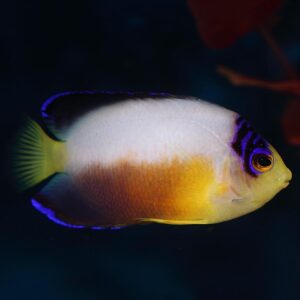The Cuban Hog (Bodianus pulchellus) can reach a maximum size of about 8 inches (20 cm) in length. It has an elongated body shape with a prominent forehead and a pointed snout. The body colouration ranges from reddish-brown to bright orange-red. It is adorned with a white bar, adding to its striking visual appeal.
Taxonomy:
The Cuban Hog belongs to the family Labridae, which includes wrasses and hogfish. It is classified under the genus Bodianus, which comprises various hogfish species. Its closest relatives within the genus include other hogfish species like the Spanish Hogfish (Bodianus rufus) and the Spotfin Hogfish (Bodianus pulchellus). The scientific name “pulchellus” is derived from the Latin word meaning “beautiful,” referring to its attractive appearance.
Natural Habitat:
The Cuban Hog is typically found in rocky reef habitats with abundant hiding spots and crevices. It inhabits both shallow and deeper waters, ranging from around 30 to 150 feet (9 to 46 meters). These areas provide the Cuban Hog with opportunities for foraging, shelter, and territorial displays.
Keeping the Cuban Hog Healthy:
The care level for the Cuban Hog is moderate, suitable for experienced marine aquarium keepers. Maintaining excellent water quality is crucial, with temperatures ranging between 72°F and 78°F (22°C and 26°C) and a pH level between 8.1 and 8.4. Regular monitoring of water parameters and proper filtration are essential for the well-being of the Cuban Hog.
Special Requirements and Feeding:
The Cuban Hog requires a varied diet consisting of high-quality marine-based foods. Offer a mix of live or frozen meaty foods like small fish, crustaceans, and brine shrimp. It is important to provide a balanced diet to ensure the Cuban Hog receives proper nutrition.
How Many Should I Keep?
It is recommended to keep the Cuban Hog individually or in pairs, as they can become territorial towards their own species or similar-looking fish. Providing ample swimming space and hiding spots in the aquarium is beneficial for their well-being.
Lighting Preference:
The Cuban Hog does not have specific lighting preferences and can adapt to a range of lighting intensities commonly used in marine aquariums.
Suitable Tank Mates:
When selecting tank mates for the Cuban Hog, choose species that are peaceful, non-aggressive, and similar in size. Avoid keeping it with overly aggressive or territorial fish that may pose a threat to its well-being. Suitable tank mates may include peaceful wrasses, tangs, and other compatible reef fish.
Reproduction in the Wild
In the wild, the Cuban Hog (Bodianus pulchellus) engages in sexual reproduction to ensure the survival of its species. Reproduction typically occurs during the warmer months when water temperatures are favourable.
Breeding: Bodianus pulchellus
- Set Up
Breeding Cuban Hogs in captivity requires a well-maintained aquarium with stable water conditions. The tank should have appropriate hiding spots and suitable substrate for egg deposition.
- Courtship/Spawning
The courtship and spawning behaviour of Cuban Hogs involve elaborate displays and rituals. Males often exhibit vibrant colours and engage in intricate fin movements to attract females. Once courtship is successful, the pair will swim together and release their gametes into the water column.
- Rearing
After spawning, the eggs are left to float freely in the water. It is essential to promptly remove the eggs from the main tank to prevent predation by other fish. The eggs should be transferred to a separate rearing tank equipped with gentle water movement and optimal water parameters. The eggs will hatch within a few days, and the larvae will begin their development.
Sexual Dimorphism
Sexual dimorphism in the Cuban Hog is not well-documented, and it may be challenging to distinguish males from females based on external characteristics alone. However, in some cases, males may exhibit more intense colouration and larger size compared to females.
Distribution
The Cuban Hog (Bodianus pulchellus) is naturally found in the Western Atlantic Ocean, specifically in the Caribbean region. It is not known to be a captive-bred or line-bred strain, and individuals available in the aquarium trade are typically sourced from the wild.
Summary
The Cuban Hog (Bodianus pulchellus) is a captivating and colourful fish species that adds vibrancy to marine aquariums. It is moderately challenging to care for due to its specific water quality requirements. The Cuban Hog thrives in aquariums with stable temperatures ranging from 72°F to 78°F (22°C to 26°C), a pH level between 8.1 and 8.4, and appropriate tank mates. Its diet should consist of high-quality marine-based foods. Breeding this species requires a well-prepared setup, including suitable hiding spots and a separate rearing tank for the eggs. While sexual dimorphism in this species may be minimal, males may display more intense colours and larger size compared to females. These fish are naturally distributed in the Western Atlantic, particularly in the Caribbean. It is important to source Cuban Hogs responsibly and legally to minimize impact on wild populations.





Reviews
There are no reviews yet.